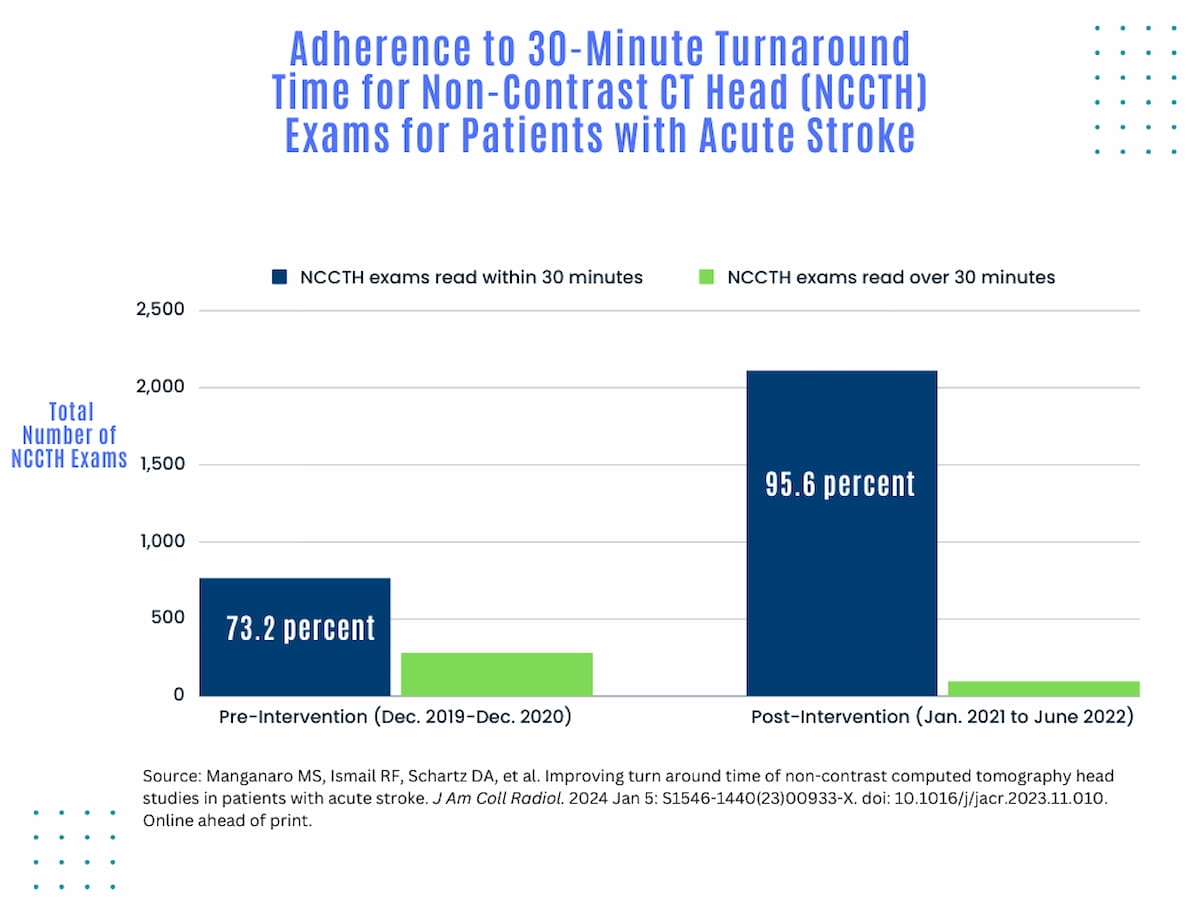Head CT for Acute Stroke Patients: Study Shows 22 Percent Improvement for 30-Minute Turnaround Times
Modifications to the radiology workflow, including the use of a structured report template, improved adherence for 30-minute turnaround times for acute stroke head CT results from 73.2 percent to 95.6 percent, accordingly to new research.
Emerging research suggests significant improvements to turnaround times for head computed tomography (CT) exams in acute stroke cases can be achieved with simple modifications to radiology workflow, including the use of a structured report template.
For the retrospective study, recently published in the Journal of the American College of Radiology, researchers reviewed 1,046 cases involving head CT turnaround times (TATs) and noted potential factors contributing to TATs of more than 30 minutes. The study authors noted that possible etiologies of prolonged TATs may include increasing imaging volume, inconsistent worklist prioritization for acute stroke triage, lack of a separate picklist for acute stroke exams and lack of a standardized template for assessing patients with acute stroke.
Accordingly, the study authors instituted a standardized preliminary structured template for head CT exams, utilized a “super stat” purple color code designation on PACS worklists for all exams with concern for stroke and emphasized reminders of TAT benchmark expectations at monthly departmental quality conferences for radiologists.
In an 18-month period after implementing radiology workflow changes, including use of a standardized structured template for head CT exams, the researchers found that 95.6 percent of 2,112 CT head exams had turnaround times (TATs) within 30 minutes in comparison to 73.2 percent of CT head exams prior to implementation of the workflow changes.

In a 18-month period after implementing these workflow changes, the researchers found that 95.6 percent of 2,112 CT head exams had TATs within 30 minutes in comparison to 73.2 percent of CT head exams prior to implementation of the workflow changes.
“The series of interventions performed to reduce the TAT of (non-contrast computed tomography head) examination completion to a preliminary digital read for acute stroke CT interpretation effectively improved the ability of our academic radiology department to meet state and national certification requirements for timely stroke care,” wrote lead study author Mark S. Manganaro, D.O., who is affiliated with the Department of Imaging Sciences at the University of Rochester Medical Center in Rochester, N.Y., and colleagues.
The study authors conceded that staggered implementation of the aforementioned workflow modifications made it difficult to determine which one had the most impact. However, they noted that the standardized template appeared to facilitate sustained improvement with 30-minute TAT adherence and emphasized that all of the workflow changes are easy to implement.
“These interventions are relatively simple and can be utilized and replicated at other radiology departments facing a similar challenge across the United States,” added Manganaro and colleagues.
Meta-Analysis Shows Merits of AI with CTA Detection of Coronary Artery Stenosis and Calcified Plaque
April 16th 2025Artificial intelligence demonstrated higher AUC, sensitivity, and specificity than radiologists for detecting coronary artery stenosis > 50 percent on computed tomography angiography (CTA), according to a new 17-study meta-analysis.
The Reading Room: Racial and Ethnic Minorities, Cancer Screenings, and COVID-19
November 3rd 2020In this podcast episode, Dr. Shalom Kalnicki, from Montefiore and Albert Einstein College of Medicine, discusses the disparities minority patients face with cancer screenings and what can be done to increase access during the pandemic.
Could Lymph Node Distribution Patterns on CT Improve Staging for Colon Cancer?
April 11th 2025For patients with microsatellite instability-high colon cancer, distribution-based clinical lymph node staging (dCN) with computed tomography (CT) offered nearly double the accuracy rate of clinical lymph node staging in a recent study.